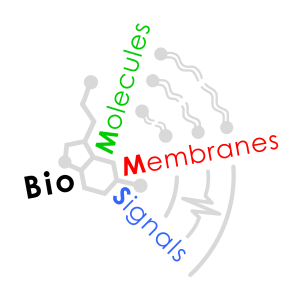Начало | Биография | Публикации | Цитирания
Публикации и цитирания (към 2016 г.)
Научни статии
- Al Sharif M, Tsakovska I, Pajeva I, Alov P, Fioravanzo E, Bassan A, Kovarich S, Yang C, Mostrag-Szlichtyng A, Vitcheva V, Worth AP, Richarz AN, Cronin MTD (2016) The Application of Molecular Modelling in the Safety Assessment of Chemicals: A Case Study on Ligand-Dependent PPARγ Dysregulation, Toxicology, doi: 10.1016/j.tox.2016.01.009 IF = 3.817 (2015)
- Fratev F, Tsakovska I, Al Sharif M, Mihaylova E, Pajeva I (2015) Structural and Dynamical Insight into PPARγ Antagonism: In Silico Study of the Ligand-Receptor Interactions of Non-Covalent Antagonists, Int J Mol Sci., 16(7):15405-24. IF = 3.257 (2015)
2 цитирания:- Batista MR, Martínez L. Conformational Diversity of the Helix 12 of the Ligand Binding Domain of PPARγ and Functional Implications. J Phys Chem B. 2015 Dec 3. DOI: 10.1021/acs.jpcb.5b09824
- Claire Louise Mellor, Fabian Pitter Steinmetz, and Mark Cronin. Using Molecular Initiating Events to Develop a Structural Alert Based Screening Workflow for Nuclear Receptor Ligands Associated with Hepatic Steatosis. Chem. Res. Toxicol., Just Accepted Manuscript DOI: 10.1021/acs.chemrestox.5b00480
- Al Sharif M, Alov P, Vitcheva V, Pajeva I, Tsakovska I (2014) Modes-of-action related to repeated dose toxicity: tissue-specific biological roles of PPARγ ligand-dependent dysregulation in nonalcoholic fatty liver disease, PPAR Research (a special issue PPARs and Metabolic Syndrome), Article ID 432647. IF = 2.935 (2015)
6 цитирания:- Angrish MM, Kaiser JP, McQueen CA, Chorley BN. Tipping the Balance: Hepatotoxicity and the 4 Apical Key Events of Hepatic Steatosis. Toxicol Sci. 2016 Apr;150(2):261-8. doi: 10.1093/toxsci/kfw018. Epub 2016 Mar 15. PubMed PMID: 26980302.
- Nuño-Lámbarri N, Barbero-Becerra VJ, Uribe M, Chávez-Tapia NC. Mitochondrial Molecular Pathophysiology of Nonalcoholic Fatty Liver Disease: A Proteomics Approach. Int J Mol Sci. 2016 Mar 15;17(3):281. doi: 10.3390/ijms17030281. Review. PubMed PMID: 26999105; PubMed Central PMCID: PMC4813145.
- Mellor CL, Steinmetz FP, Cronin MT. The identification of nuclear receptors associated with hepatic steatosis to develop and extend adverse outcome pathways, Crit Rev Toxicol. 2016 Feb;46(2):138-52. doi: 10.3109/10408444.2015.1089471
- Barbosa AM, Francisco PC, Motta K, Chagas TR, dos Santos C, Rafacho A, Nunes E. Fish Oil Supplementation Attenuates the Changes in the Plasma Lipids Caused by Dexamethasone Treatment in Rats, Appl Physiol Nutr Metab, 2015, doi: 10.1139/apnm-2015-0487
- V. Zuang,B. Desprez, J. Barroso, S. Belz, E. Berggren,, C. Bernasconi, J.Bessems, S.e Bopp, S. Casati, S. Coecke, R. Corvi, C. Dumont, V. Gouliarmou, C. Griesinger, M. Halder, A. Janusch-Roi, A. Kienzler, B. Landesmann, F. Madia, A. Milcamps, S. Munn, A. Price, P. Prieto, M. Schäffer, J. Triebe, C. Wittwehr, A. Worth, M. Whelan.. EURL ECVAM status report on the development, validation and regulatory acceptance of alternative methods and approaches, European Union, 2015, pp. 1-114
- Chikamoto K, Misu H, Takayama H, Kikuchi A, Ishii KA, Lan F, Takata N, Tajima-Shirasaki N, Takeshita Y, Tsugane H, Kaneko S, Matsugo S, Takamura T. Rapid response of the steatosis-sensing hepatokine LECT2 during diet-induced weight cycling in mice. Biochem Biophys Res Commun. 2016 Aug 22. pii: S0006-291X(16)31381-X. doi: 10.1016/j.bbrc.2016.08.117. [Epub ahead of print] PubMed PMID: 27562717.
- Tsakovska I., Al Sharif M, Alov P, Diukendjieva A, Fioravanzo E, Cronin M.T.D, Pajeva I (2014) Molecular modelling study of PPARγ receptor in relation to the mode of action / adverse outcome pathway framework for liver steatosis. Int. J. Mol. Sci., 15, 7651-7666. (ISSN 1422-0067). IF = 3.257 (2015)
3 цитирания:- Allen TE, Goodman JM, Gutsell S, Russell PJ. Defining molecular initiating events in the adverse outcome pathway framework for risk assessment. Chem Res Toxicol. 2014 Dec 15;27(12):2100-12. doi: 10.1021/tx500345j. Epub 2014 Nov 10. PubMed PMID: 25354311.
- Zuang V, Desprez B, Barroso J, Belz S, Berggren E, Bernasconi C, Bessems J, Bopp S, Casati S, Coecke S, Corvi R, Dumont C, Gouliarmou V, Griesinger C, Halder M, Janusch-Roi A, Kienzler A, Landesmann B, Madia F, Milcamps A, Munn S, Price A, Prieto P, Schäffer M, Triebe J, Wittwehr C, Worth A, Whelan M. EURL ECVAM status report on the development, validation and regulatory acceptance of alternative methods and approaches, European Union, 2015, pp. 1-114.
- Hewitt M, Przybylak K. In Silico Models for Hepatotoxicity. Methods Mol Biol. 2016;1425:201-36. doi: 10.1007/978-1-4939-3609-0_11. PubMed PMID: 27311469.
Доклади
- Al Sharif M, Alov P, Tsakovska I, Pajeva I. (2015) In silico modelling of full PPARγ agonists: a step towards liver steatosis risk assessment, International Conference Of Young Scientists, 11 – 12 June 2015, Plоvdiv, Bulgaria, Scientific Researches of the Union of Scientists in Bulgaria – Plovdiv, Series G. Medicine, Pharmacy and Dental medicine, Vol. XVII, p. 182-186, ISSN1311-9427.
Глави от книги
- Odjakova M, Popova E, Al Sharif M and Mironova R (2012). Plant-Derived Agents with Anti-Glycation Activity, Glycosylation, Dr. Stefana Petrescu (Ed.), ISBN: 978-953-51-0771-2, InTech, DOI: 10.5772/48186.
12 цитирания:- Jagdale AD, Bavkar LN, More TA, Joglekar MM, Arvindekar AU. Strong inhibition of the polyol pathway diverts glucose flux to protein glycation leading to rapid establishment of secondary complications in diabetes mellitus. J Diabetes Complications. 2016 Apr;30(3):398-405. doi: 10.1016/j.jdiacomp.2016.01.001. Epub 2016 Jan 6. PubMed PMID: 26896333.
- West BJ, Deng S, Uwaya A, Isami F, Abe Y, Yamagishi SI, Jensen CJ. (2016) Iridoids are natural glycation inhibitors. Glycoconj J. [Epub ahead of print] PubMed PMID: 27306206.
- Nancy, P., Ashlesha, V. (2016). Pharmacognostic and phytochemical studies of Cassia absus seed extracts. International Journal of Pharmacy and Pharmaceutical Sciences, 8 (1), 325-332
- Kamble, L. H., & Sonkamble, V. V. (2015). Antidiabetic Potential and Identification of Phytochemicals from Tinospora cordifolia. Advanced Journal of Phytomedicine and Clinical Therapeutics, 3(1), 097-110.
- Miranda, J., Lasa, A., Aguirre, L., Fernandez-Quintela, A., Milton, I., Portillo, M.P. (2015). Potential Application of Non-flavonoid Phenolics in Diabetes: Antiinflammatory Effects Source: Current Medicinal Chemistry, 22(1), 112-131.
- Perera, P. R. D., Ekanayake, S., & Ranaweera, K. K. D. S. (2014). Antiglycation and antioxidant activities of a ready to serve herbal drink of Syzygium Cumini bark extract. Medicinal & Aromatic Plants, 3(1), 148.
- Perera, K. I., & Ranasinghe, H. A. S. K. (2014). A simple method to detect plant based inhibitors of glycation induced protein cross-linking. Asian Journal of Medical Sciences (ISSN 2091-0576), 6(1), 28-33.
- Perera, H. K. I., & Handuwalage, C. S. (2014). Detection of protein glycation inhibitory potential of nine antidiabetic plants using a novel method. Asian Journal of Medical Sciences (ISSN 2091-0576), 6(2), 1-6.
- Houda, M., Derbré, S., Jedy, A., Tlili, N., Legault, J., Richomme, P., … & Saidani-Tounsi, M. (2014). Combined anti-ages and antioxidant activities of different solvent extracts of Solanum elaeagnifolium Cav (Solanacea) fruits during ripening and related to their phytochemical compositions.
- Barakat W, Hassan R, Askar M, Fahmy A, (2014) Role of aldose reductase and arginase inhibitors in diabetic vascular and behavioral complications. Zagazig J. Pharm. Sci, 23 (1),58-72, ISSN 1110-5089.
- Perera, P. R. D., Ekanayaka, S., & Ranaweera, K. K. D. S. (2013). Phytochemical screening and in vitro antiglycation and antioxidant activity of water extract of Syzygium cumini bark. J Phytochem Photon, 114, 188-195.
- Perera PRD, Ekanayake S, Ranaweera KKDS (2013). Antiglycation and Antioxidant Activities of a Ready to Serve Herbal Drink of Syzygium Cumini Bark Extract. Med Aromat Plants 3:148. doi: 10.4172/2167-0412.1000148
Резюмета от конференции, публикувани в научни списания
- Tsakovska I, Al Sharif M, Fioravanzo E, Bassan A, Kovarich S, Vitcheva V, Mostrag-Szlichtyng A, Yang C, Steinmetz F, Cronin M (2015) In silico approaches to support liver toxicity screening of chemicals: Case study on molecular modelling of ligands–nuclear receptors interactions to predict potential steatogenic effects. Toxicology Letters 238 Supplement: S173 IF = 3.522 (2015)
- Vitcheva V, Mostrag-Szlichtyng A, Sacher O, Bienfait B, Schwab CH, Richarz A, Tzakovska I, Al Sharif M, Pajeva I, Yang C (2015) In vivo data mining and in silico metabolic profiling to predict diverse hepatotoxic phenotypes: Case study of piperonyl butoxide. Toxicology Letters 238 Supplement: S173 IF = 3.522 (2015)
- Vitcheva V, Al Sharif M, Tsakovska I, Alov P, Mostrag-Szlichtyng A, Cronin MTD, Yang C, Pajeva I (2014) Description of the MoA/AOP linked with PPARgamma receptor dysregulation leading to liver fibrosis. Toxicology Letters 229 Supplement: S49 IF = 3.522 (2015)
- Diukendjieva A, Al Sharif M, Alov P, Tsakovska I, Pajeva I, PPARγ agonists and liver steatosis: mode-of-action characterisation and in silico study, Journal of Biomedical and Clinical Research, vol.7, n.1, suppl.1, 2014, p.39
- Al Sharif M, Tsakovska I, Alov P, Vitcheva V, Pajeva I (2014) PPARγ-related hepatotoxic mode-of-action: quantitative characterization and in silico study of the molecular initiating event involving receptor activation. Altex Proceedings 3, 1/14: 56-57 IF= 5.824 (2015)
- Al Sharif M, Alov P, Cronin M, Fioravanzo E, Tsakovska I, Vitcheva V, Worth A, Yang C, Pajeva I (2013) Toward better understanding of liver steatosis MoA: Molecular modelling study of PPAR gamma receptor. Toxicology Letters 221 Supplement: S85 IF = 3.522 (2015)
1 цитиране:- Sullivan KM, Manuppello JR, Willett CE. Building on a solid foundation: SAR and QSAR as a fundamental strategy to reduce animal testing. SAR QSAR Environ Res. 2014, 25: 357-365.








